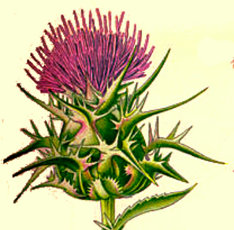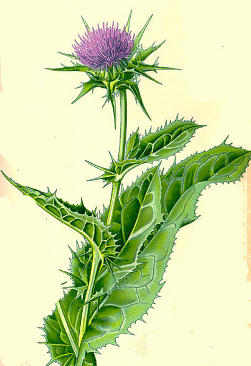 Silybum marianum
Silybum marianumMilk Thistle
Long considered protective against snakes and their bites, you'd think such a thorny critter as milk thistle would be a Mars herb. Yet it's typically thought to be a Jupiter plant, because it is tall and imposing and good for liver ailments, which is Jupiter's field of medicine. Because the liver is traditionally the seat of anger, some magic practitioners believe that the wearing of milk thistle potentiates anger. It would certainly be uncomfortable. Eliphas Levi describes malicious sorcerers who drowned vipers and asps in milk to which milk thistle sap had been added to create a virulent poison, an example of Mars work. It is the herb associated with the star Aldebaran, which in turn represents the Archangel Michael, a Fire spirit. The flowers can be either purple (Jupiter) or a rosy red (Mars), so it's a tossup whether this magic herb is Mars or Jupiter. Either way, it is good for all sorts of magical protection.
Mundane Uses
 Although all parts of this plant are edible, they
all need preparation first, primarily in terms of removing prickly
or tough parts. Also known as Marian, Mary's Thistle, St. Mary's,
wild artichoke, variegated thistle. Not the same thing as blessed
thistle, which is Cnicus benedictus and which is the thistle for
milk production. Although this is called milk thistle, it is actually
not helpful for that but for "melancholy" or liver-based
diseases; Culpeper, for instance, recommended it for jaundice. In
Europe, it is the antidote of choice for poisoning by death cap
mushroom (Amanita phalloides), which is a hepatotoxin, and it does
indeed work, regenerating liver cells, but if you are poisoned by
such a mushroom, go to the hospital instead of the garden. There
is a story that milk thistle got its name because Mary spilled her
milk on it after being pricked by its thorns, but it could be that the
name comes from the fact that the young, despined
leaves were typically boiled with milk for a remedy.
Although all parts of this plant are edible, they
all need preparation first, primarily in terms of removing prickly
or tough parts. Also known as Marian, Mary's Thistle, St. Mary's,
wild artichoke, variegated thistle. Not the same thing as blessed
thistle, which is Cnicus benedictus and which is the thistle for
milk production. Although this is called milk thistle, it is actually
not helpful for that but for "melancholy" or liver-based
diseases; Culpeper, for instance, recommended it for jaundice. In
Europe, it is the antidote of choice for poisoning by death cap
mushroom (Amanita phalloides), which is a hepatotoxin, and it does
indeed work, regenerating liver cells, but if you are poisoned by
such a mushroom, go to the hospital instead of the garden. There
is a story that milk thistle got its name because Mary spilled her
milk on it after being pricked by its thorns, but it could be that the
name comes from the fact that the young, despined
leaves were typically boiled with milk for a remedy.
How to Grow Milk Thistle
Start indoors 6 weeks before last frost to have blooms the first year. It germinates in 7-14 days at room temperature for transplants or direct sow outside after danger of frost for blooms typically in the second year, after which it produces seeds and dies. This plant is big and thorny; plant it where it can have room. It gets 4-6ft/1.2-1.8m tall and is typically planted 24-36in/60-90cm apart. Flowers get 2in/5cm wide and might take two years to show up, as this plant can be a biennial (hardy down to -20F/-29C) but is more typically an annual. Goldfinches love the seeds, and butterflies and sphinx and hawk moths love the flowers. Wear HEAVY gloves when handling. Parachutes of seeds have to be removed before storage; wear gloves and rub seeds on a screen or sieve to do that. To use medicinally, grind the seeds and make a tincture, pouring brandy or vodka to a finger's width above the top of the seeds in a jar. Let infuse for one moon and the strain. You can also tincture the plant material instead. General growing info
Silybum marianum
Milk Thistle
20 seeds $3.75
This seed cannot be shipped to Texas.
Uses in Witchcraft & Magic:
Protection Magic
Jupiter
or Mars Herb
© 2011-2024 Alchemy Works;
No reproduction without permission